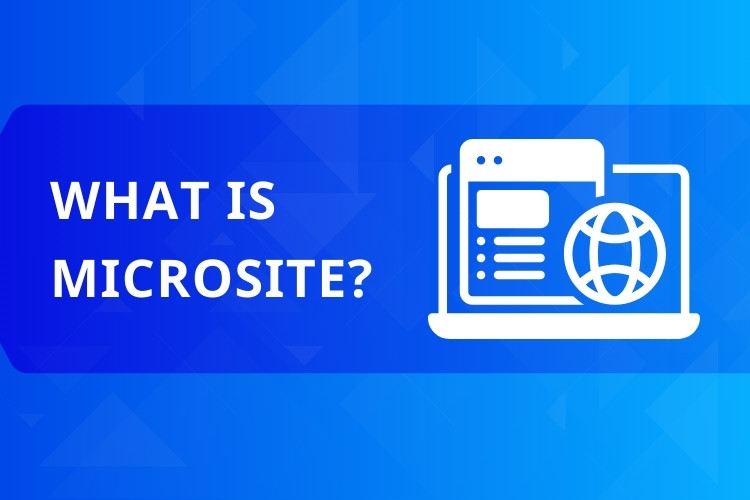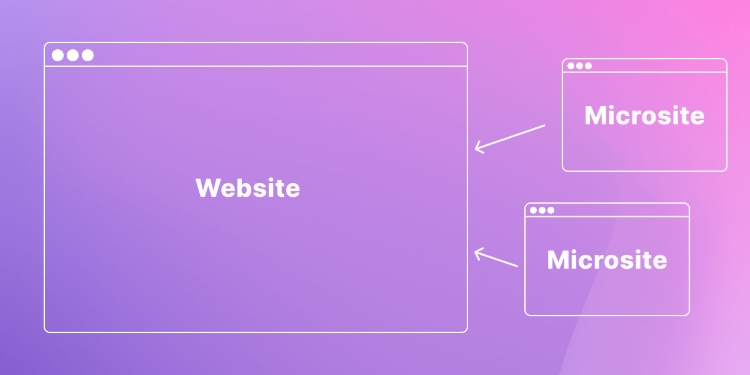In today’s complex digital landscape, businesses use various online platforms to connect with audiences. Beyond the main company website, specialized tools exist for targeted communication. One such powerful tool is the microsite, increasingly relevant in 2025’s dynamic marketing environment.
This guide provides a comprehensive look at microsites. We’ll explore exactly what they are, their key features, why and when to use them, and how they differ from other web presences. We’ll also look at real-world applications to clarify their value.
What is a Microsite?
A microsite is a small, distinct website or a single web page with its own unique web address (URL) or subdomain, separate from an organization’s main website. It is built for a specific purpose, focusing intensely on a particular product, service, event, campaign, or target audience.
Think of it as a focused mini website. Unlike a large corporate site covering everything, a microsite zooms in on one topic. This standalone site approach offers a dedicated space for specific goals, messages, and interactions away from the breadth of the main company presence.
This separation allows for tailored content and design. The primary goal is to provide a focused experience, directly addressing a specific user need or interest related to that single topic. It avoids the navigational complexity of a full corporate website.

Key Characteristics of a Microsite
Several distinct features define a microsite and differentiate it from other online assets. Understanding these characteristics helps clarify their unique role and potential applications in digital marketing and web development. Let’s explore these defining traits.
Separate Domain or Subdomain
A core feature is its unique web address. A microsite typically lives on a separate domain name (like YourSpecialCampaign.com) or a dedicated subdomain of the main site (like event.YourCompany.com). A domain is the main web address people type in browsers.
A subdomain is a prefix added to the main domain, creating a distinct section. This separate URL structure is fundamental. It technically and perceptually separates the microsite from the main corporate website, signaling its specific, focused nature to both users and search engines.
This independence allows for tailored technical setups if needed. It reinforces the idea that the user is entering a space dedicated solely to the microsite’s specific topic, whether it’s a product launch or a marketing campaign.
Highly Focused Content Scope
Microsites are deliberately narrow in scope. All content—text, images, videos, interactive elements—directly relates to the single topic, campaign, product, or event it was built for. There’s no room for unrelated company news or broader brand information.
This laser focus contrasts sharply with a comprehensive main website. A corporate site must cater to diverse audiences and cover many topics. A microsite provides depth on one subject, offering a clutter-free experience for users interested specifically in that niche.
This targeted approach enhances clarity and relevance for the visitor. It ensures the message is undiluted and directly supports the microsite’s primary objective, making it a potentially highly effective communication tool for specific goals, sometimes resembling a niche website in its focus.
Distinct Branding and Design
Often, microsites feature unique branding or design elements. While they usually maintain some connection to the parent brand, the visual identity might differ significantly to match a specific campaign theme, target audience aesthetic, or product personality.
This flexibility is a key advantage. Marketers can create a look-and-feel optimized for the specific initiative without being constrained by the rigid branding guidelines of the main corporate website. This helps create a more immersive or contextually appropriate user experience (UX).
For example, a microsite for a youth-focused product might use bolder colors and more dynamic layouts than the conservative main brand site. This distinct brand identity helps resonate better with the intended target audience and the campaign’s specific messaging.
Independent Navigation
Navigation within a microsite is usually self-contained. Users can explore different pages or sections within the microsite, but the navigation menu typically doesn’t link back to the main categories or sections of the parent company’s primary website.
This creates a contained journey focused solely on the microsite’s content. While a link back to the main corporate site (often in the footer) is common for brand association, the primary navigation keeps the user within the specialized environment, reinforcing its focus.
This prevents users from getting sidetracked by unrelated content on the main site. It ensures their attention remains on the specific campaign, product, or event the microsite is promoting, guiding them towards the intended goal or information.
Specific Call-to-Action (CTA)
Microsites are almost always built around a specific goal, reflected in a clear Call-to-Action (CTA). A CTA prompts the user to take a desired next step, such as signing up for a newsletter, downloading a whitepaper, registering for an event, or learning more about a product.
Unlike main websites that often have multiple competing CTAs, a microsite typically emphasizes one or two key actions directly related to its focused purpose. This clarity helps guide the user journey and increases the likelihood of achieving the site’s specific objective.
This goal-oriented design makes microsites highly effective tools for measurable results. Whether the goal is lead generation, event registration, or product awareness, the focused CTA helps drive and track conversions effectively.
Why Use a Microsite? Main Purposes and Benefits
Companies invest in microsites for strategic reasons. They offer distinct advantages for specific scenarios where the main website might be too broad or restrictive. Understanding these purposes highlights the value microsites bring to a marketing strategy.

Targeted Marketing Campaigns
Microsites excel as dedicated hubs for specific marketing campaigns. Whether it’s a seasonal promotion, a contest, or an awareness initiative, a campaign website provides a focused destination for all campaign-related content and activities.
This allows marketers to track campaign performance accurately using Key Performance Indicators (KPIs). KPIs are measurable values demonstrating how effectively a company is achieving key business objectives. A microsite isolates campaign traffic and conversions for clearer analysis.
New Product or Service Launches
Launching a significant new product or service? A microsite (product launch site) offers a dedicated space to showcase it in detail. You can include comprehensive features, benefits, specifications, testimonials, and purchasing information without cluttering the main site.
This focused environment allows potential customers to explore the new offering without distractions. It ensures the product’s unique value proposition is communicated clearly and effectively, potentially leading to higher initial interest and adoption rates compared to burying it within a large corporate site.
Hosting Events (Online or Offline)
Microsites are ideal for managing information related to events like conferences, trade shows, webinars, or festivals. An event website acts as a central repository for schedules, speaker bios, registration forms, venue details, sponsor information, and post-event resources.
This simplifies communication for organizers and attendees. It provides a single, easy-to-navigate source for all event-related information, separate from the organizing body’s main website, enhancing the overall event experience for everyone involved.
Enhancing User Engagement
The focused nature of microsites allows for more creative and engaging user experiences. You can incorporate interactive elements, games, quizzes, specialized calculators, or unique content formats tailored specifically to the campaign or topic.
This can significantly boost user engagement compared to a standard corporate webpage. By providing a unique and relevant experience (UX), microsites can capture audience attention more effectively and foster a stronger connection with the brand or initiative.
Generating Qualified Leads
Because microsites attract visitors interested in a very specific topic, they are excellent tools for lead generation. Calls-to-action like newsletter sign-ups, demo requests, or resource downloads are more likely to attract genuinely interested prospects (qualified leads).
The focused context means the leads generated are often of higher quality than those from broader website forms. These individuals have shown specific interest, making follow-up marketing efforts more effective and improving overall conversion rate optimization (CRO).
Reaching Specific Audience Segments
Need to speak directly to a niche audience with tailored messaging? A microsite allows you to customize content, tone, and design to resonate perfectly with a specific target audience segment, without affecting the broader appeal of the main website.
For example, a tech company could create a microsite specifically for software developers, using technical language and visuals that appeal to them, separate from their main site which might target business decision-makers. This segmentation enhances communication effectiveness.
Microsite vs. Landing Page vs. Main Website: Understanding the Differences
The term ‘microsite’ is sometimes confused with ‘landing page’ or just a ‘section of a website’. While related, they serve distinct purposes within website architecture. Clarifying these differences is key to using each effectively.
Microsite vs. Landing Page
A landing page is typically a single web page designed for one specific goal – usually an immediate conversion like signing up, downloading something, or making a purchase. It often resides on the main website’s domain (e.g., company.com/special-offer).
A microsite, conversely, can consist of multiple pages (though sometimes it might be just one). It has its own navigation, explores a topic in more detail, and resides on a separate domain or subdomain. Its focus is broader than a single conversion action, often aiming for deeper engagement or information delivery around a campaign or topic.
Think of a landing page as a focused advertisement leading to one action. A microsite is more like a mini-magazine or detailed brochure on a specific subject, potentially containing several related calls-to-action across its pages.
Microsite vs. Main Website Section/Subdomain
Adding a new section to your main site (e.g., company.com/new-product) is different from creating a microsite (e.g., new-product.company.com or newproductcampaign.com). A website section inherits the main site’s branding, navigation, and technical framework.
A microsite offers greater independence. You gain flexibility in design, branding, navigation, and even the underlying technology (content management system or CMS). This separation is crucial for distinct campaigns or temporary initiatives where blending into the main site isn’t desirable or practical.
Furthermore, using a separate domain or subdomain clearly signals the specialized nature of the content. It helps manage user expectations and allows for distinct SEO strategies if needed, treating the microsite as a separate entity online.
Examples of Effective Microsites
To make the concept more concrete, let’s imagine some diverse examples of how microsites are used effectively across different scenarios in 2025:
Example 1: Automotive Launch A car manufacturer launches a groundbreaking electric vehicle (EV). They create FutureEV.com. This microsite features stunning visuals, detailed specs, interactive range calculators, virtual test drives, pre-order forms, and blog posts specifically about EV technology. It’s separate from the main manufacturer site showcasing all car models.
Example 2: Non-Profit Fundraising Drive A global charity initiates a campaign to provide clean water. They launch CleanWaterInitiative.org. The site tells impactful stories through videos and photos, explains exactly how donations are used, features a prominent donation CTA, and tracks fundraising progress in real-time. It’s distinct from the main charity site covering all their programs.
Example 3: Tech Conference A major software company hosts its annual developer conference. They use DevCon2025.techcompany.com. This microsite includes the full agenda, speaker profiles with session details, venue maps, registration links, sponsor showcases, and eventually, recordings of the sessions. It serves purely event-related needs.
Example 4: Food Brand Recipe Contest A popular snack brand runs a summer recipe contest. They create SnackRecipeChallenge.com. Users can submit recipes featuring the snack, browse other entries, vote for favorites, and see contest rules and prizes. The design is bright, fun, and engaging, different from the corporate brand site.
These examples illustrate the focused nature and varied applications of microsites – each serving a specific goal with tailored content and design, separate from the organization’s primary web presence. They provide dedicated spaces for specific interactions.

When Should You Consider Building a Microsite?
Deciding whether to build a microsite depends on your specific goals and resources. It’s not always the right choice, but it’s highly effective in certain situations. Consider using a microsite if:
- You need a distinct brand identity or user experience for a specific campaign that doesn’t fit your main website’s style. This allows creative freedom.
- You are launching a major new product or service that requires detailed explanation and focused attention, away from other company offerings.
- You are organizing a significant event (conference, festival, etc.) that needs a dedicated information hub for attendees and participants.
- You want to heavily target a very specific niche audience with tailored messaging and content that might alienate or confuse your broader audience.
- The initiative is temporary or short-term, and you want to keep its content separate from your evergreen main site structure.
- You need to test a new concept, product idea, or marketing approach in an isolated environment before potentially integrating it more broadly.
If your needs align with these scenarios, a microsite offers a powerful, focused solution. It allows for targeted communication and experiences that might be diluted or compromised within the structure of a larger, multi-purpose corporate website.
Potential Downsides and Considerations
While powerful, microsites aren’t without challenges. Before committing, consider these factors to ensure it’s the right strategic move and that you’re prepared for the implications (aligning with E-E-A-T principles of realistic assessment).
Development Resources (Time & Cost): Building a microsite requires resources: design, web development, content creation, and potentially separate hosting. It’s essentially creating another website, even if small, which demands budget and personnel time that must be factored into your planning.
SEO Strategy Integration: A new domain for a microsite starts with zero search engine authority. Building its visibility through Search Engine Optimization (SEO) takes time and effort. SEO involves optimizing content and technical aspects to rank higher in search results like Google.
Using a subdomain can leverage some of the main domain’s authority, but it still requires a distinct SEO strategy. You need to consider how the microsite fits into your overall online presence and search visibility goals. Careful planning is needed to avoid duplicating content or confusing search engines.
Maintenance Requirements: Like any website, a microsite needs ongoing maintenance. This includes software updates, security patches, content refreshes (if not purely temporary), and eventual archiving or decommissioning plans if the site is for a limited-time campaign or event.

Is a Microsite Right for Your Needs?
Microsites are specialized tools in the digital marketing toolkit. They are defined by their separation from the main corporate website, their tight focus on a specific topic or goal, and their often unique branding or design. They provide dedicated spaces for campaigns, product launches, events, and targeted audience engagement.
By understanding their key characteristics, primary uses, and how they differ from landing pages and main website sections, you can make informed decisions. Weigh the benefits of focus and tailored experiences against the considerations of resources, SEO, and maintenance. When used strategically for the right purpose, a microsite can deliver powerful, measurable results for your organization in 2025.
Ensuring your microsite delivers a smooth, responsive user experience often starts with a capable hosting foundation, especially for reaching audiences effectively. For reliable performance grounded in the region, explore options like Vietnam VPS. Their services utilize quality, new-generation hardware including AMD EPYC Gen 3 processors and fast SSD NVMe U.2 storage, providing stable, high-speed configurations with generous bandwidth.
